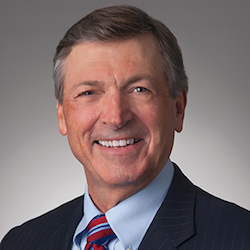
Kevin O’Neil, M.D., joined Ascension Living as chief medical officer in October after having served in the same position at Brookdale Senior Living for 10 years. He recently spoke with McKnight’s Senior Living Senior Editor Lois A. Bowers.
What appealed to you about joining Ascension?
The intense focus on safety, quality of care and efficiency. Ascension recognizes that, in this new value-based environment, we not only have to do things with good quality, but we have to be cognizant of the costs associated with that care and do it as efficiently as possible. We have to be good stewards of the resources that we have. Ascension is working hard in its senior living communities to put the infrastructure in place to mitigate risk for adverse events.
I often use the analogy of the airline industry. What helps reduce errors in the airline industry is the use of checklists and protocols and algorithms. Not that it should replace critical thinking, but we know that, often, it’s the stuff that falls through the cracks, communication gaps that occur, that can give rise to trouble. We’re really intensely focused on how we can tighten up our processes to mitigate the risk of miscommunication and to ensure that appropriate protocols have been followed.
I use medications as an example because missed medications and medications adversely interacting with other medications or with supplements — those are the kind of things that we need to critically assess in our population. When a person comes to us in the skilled nursing or the long-term care setting or home settings, we want to make sure that important medicines are not neglected or forgotten.
Can you provide an example of the infrastructure changes you are talking about?
When I came on board, I recognized that we had certain issues related to star ratings for F-tags. Thinking as a physician, I look at those as signs and symptoms of a problem.
Studies clearly have shown that more important than the environment, more important than the food, more important than the programs, is having a consistent, competent, caring staff, because those relationships that are created are so important.
One of my big focuses right now is how we can eliminate staff turnover, how we recruit those good, competent people, and how we keep them and develop them. The key to the future to maintain quality and safety is going to be having that good, caring, competent staff.
Also, we’re going to start implementing the INTERACT (Interventions to Reduce Acute Care Transfers) program in our skilled nursing buildings, and implementing it robustly. Our teams are going to start their training in June.
We’re going to do the initial pilot in Waco, TX, at Providence Park, then plan on replicating in the other communities. Initially, we’ll focus on those skilled communities that are in geographic proximity to Ascension hospitals, so that we can really build that transition bridge.
We are going to be using the modified protocols for assisted living as well, concomitantly with the skilled. We’re going to tell the folks, “The assisted living population is not too dissimilar these days from the skilled population.”
Can you tell us how your role extends beyond the senior living portion of the company?
I’m also working with the Ascension Health group as the geriatric lead. Thinking as a geriatrician, thinking holistically, we really need to be evaluating older adults, as they leave the hospital, for things that are unrelated to the primary disease. We need to think about the cognitive and functional status of that person and think about the caregiver support that they have.
What often happens is, people get home and their families get stressed and anxious and don’t know what to do. The next thing you know, they’re back in the ER. It may have had nothing to do with clinical deterioration. It may have been just due to the stress of the caregiver. There are actually validated tools out there — one is called the Caregiver Strain Index, and the other is called the Preparedness for Caregiving Scale — that we can utilize to assess that.
These are some of the things that I’ve been discussing with my acute care colleagues that we need to be thinking about as we transition people from the acute care setting to post-acute and long-term care or to the home setting.
We’re also looking at advance care planning. One of the reasons that many folks are bouncing back and forth to the hospital, especially in the last few years of life, is that they’re often at the terminal phase of a disease trajectory. The average time in hospice hasn’t changed in 10 years. We’re waiting too long to be having these conversations.
Happily, the Centers for Medicare & Medicaid Services has now approved two new codes for physicians to engage in conversations around advance care planning. I think if people really understood the nature of their disease, the prognosis, that far fewer of them would elect to be subjected to some very burdensome and intrusive interventions. I think they would be more likely to choose a palliative or hospice care plan.
And are you still on the faculty at University of South Florida School of Aging Studies?
Yes. One of the thoughts I have is to go to the nursing schools and the certified nursing assistant programs and start educating them about the potential and the opportunity and the huge need that there is going to be in geriatric care and senior living. How how do we attract young men and women to careers in this field?
I’m trying to think outside the box. One of the thoughts I have is doing something along the idea of a co-op program like the one at Northeastern University in Boston. Students get paid to do onsite work with companies while they’re going through school, then the companies recruit some of the students.



